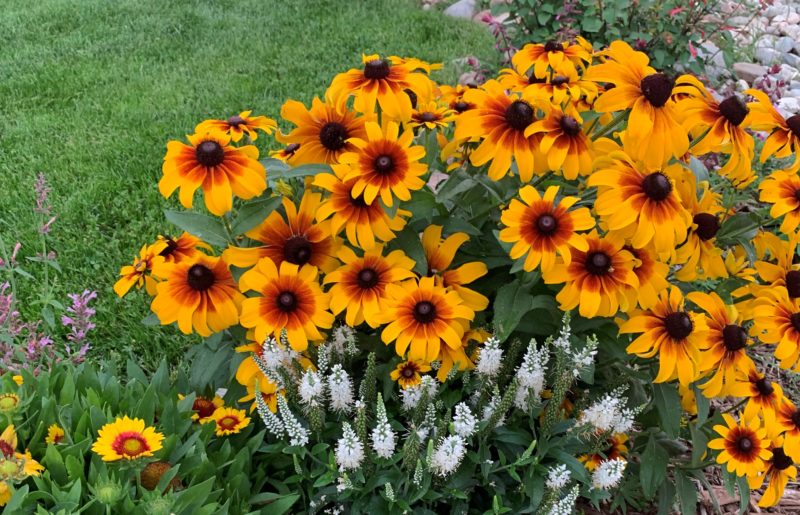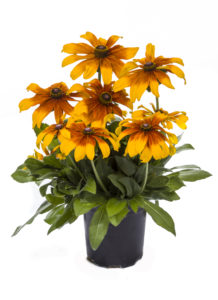
Culture Report: Rudbeckia ‘Rising Sun Chestnut Gold’
The genus of Rudbeckia hirta has long been a staple crop in North America. One of the most easily recognized plants by the general consumer, rudbeckia has long exhibited excellent sell through. Traditionally, the finished containers of rudbeckia hitting the shelves signifies the end of summer and the beginning of the fall market sales window. This is also when consumer traffic is low and more dependent on the weather.
Rudbeckia ‘Rising Sun Chestnut Gold’ is a true Rudbeckia hirta that produces an abundance of massive, bicolored blossoms all season long. However, it is not a traditional rudbeckia! Rising Sun is not an obligate long day plant like all other hirta, it is a class first as it requires no specific day length for flower induction. Rising Sun is the first ever day length neutral Rudbeckia hirta. This revolutionary attribute allows for spring finishing just as easily as summer or fall without the need for supplemental lighting. Due to the thickness of the flower petal, Chestnut Gold’s blooms will last beautifully for five to six weeks per flower. This equates to excellent hold time should the crop finish before the season opens. USDA hardy to Zone 7, it will overwinter easily in the Southern regions of North America.
 Rudbeckia ‘Rising Sun Chestnut Gold’ is produced by our partners at Vivero Internacional as a vegetative unrooted cutting. This unique attribute for a hirta reduces total crop time compared to seed by four to six weeks. Chestnut Gold’s daylength neutrality means that it does not require premium lit space in order to initiate bud set. It is also dramatically less expensive than the varieties produced by tissue culture. This allows Chestnut Gold to look like a premium product but maintain generic price point detail.
Rudbeckia ‘Rising Sun Chestnut Gold’ is produced by our partners at Vivero Internacional as a vegetative unrooted cutting. This unique attribute for a hirta reduces total crop time compared to seed by four to six weeks. Chestnut Gold’s daylength neutrality means that it does not require premium lit space in order to initiate bud set. It is also dramatically less expensive than the varieties produced by tissue culture. This allows Chestnut Gold to look like a premium product but maintain generic price point detail.
Propagation. The rooting and finishing of Rising Sun is quite simple and amazingly quick. The cuttings should be on the priority list for sticking as soon as possible upon receipt due to the amount of trichomes (hairs) on the leaf and stem. They prefer to not be held in the cooler for more than one day after arrival. Because Rising Sun is day length neutral you will often see budding during propagation. This initiation will not impede the rooting process, and we recommend saving the pinch until time of transplant into the finished container in order to be efficient on labor.
Incoming URCs are larger and will be best suited for 72-cell trays. Rising Sun will rehydrate quickly. Maintain root zone temp of 68 to 72° F for the first eight to 10 days or until root emergence is prevalent. Foliar K-IBA with rates of 200 to 250 ppm will hasten the propagation process. Anticipate five weeks propagation time that includes the hardening phase. Rising Sun has shown phytotoxicity to Florel applications above 175 ppm. A fungicide day of or day after stick is recommended. We have seen excellent results with Pageant at a rate of 8oz/100g.
Temperature. Recommended temperature is 68 to 72°F days and 60 to 65°F nights. Cooler nights once established enhance finished quality. ‘Rising Sun Chestnut Gold’ is hardy to Zone 7. These rudbeckia will continuously flower
all spring and summer in containers and landscape the first year of production from stock.
Media and pH. Use a well-drained soil mix with a pH range of 5.8 to 6.2. Water well, and allow soil to dry between irrigation. Avoid over watering especially during cool, cloudy weather.
Fertilizer. Application of 150- to 175-ppm nitrogen is recommended. Applying an occasional clear-water irrigation is recommended for maximum growth and root quality.
Pinching. Pinching is recommended at time of transplant. This rudbeckia will initiate and flower through the finishing time allotted, but unlike most vegetative annuals, this flowering will not delay the vegetative bulking of the plant.
Growth regulators. B-Nine is beneficial for uniformity in the crop. Trials are recommended, but rates of 2,500 ppm have proven adequate on 12- to 14-day intervals. Avoid paclobutrazol as this will severely decrease flower size and will often cause flowering below the foliage.
Disease and insect pests. Mites, thrips and aphids, Pythium and Phytophthora.


 Video Library
Video Library 




















